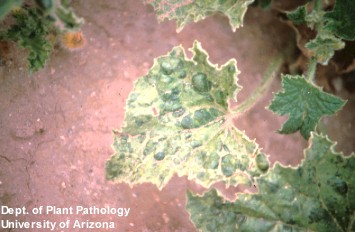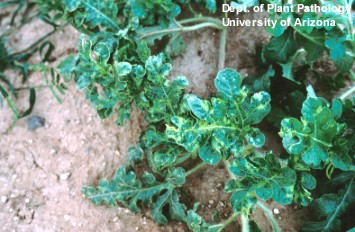 |
|
|
|||||||||||||
|
|
|||||||||||||||
|
|
|||||||||||||||
|
Yuma Agricultural Center, 6425
W. 8th St., Yuma, AZ 85364 |
|||||||||||||||
|
March 17, 2003 Head lettuce, leaf lettuce, romaine and broccoli harvests in the Yuma
and Gila Valleys are almost complete. A little acreage still remains
in the Dome Valley/Tacna area where harvest of these crops may continue
on for a couple of weeks. Quality is marginal in some fields. Most brassica
seed crops are in various stages of bloom or seed maturation. Winter
wheat production is progressing well with early plantings in boot and
heading stages. Cotton planting continues with considerable acreage
already established in cotyledon and seedling stages. Spring melon planting
appears to be completed and established stands have appeared to go through
the cooler March weather in good shape. Melons planted under plastic
(mid-bed trench) are growing well, and most plastic has been removed
and bees placed in fields. Pest Management Update: The recent rains in February and March have prompted the emergence of a number of weeds within the Yuma area. This may play an important role in maintaining aphid and other plant bug populations going into the melon season. As most are aware, this has been an extremely bad year for aphids. In fact, aphid populations this spring are the highest I have seen since I first began working at the YAC in 1990. There were isolated reports of foxglove aphid causing economic losses in head lettuce, and cabbage aphid causing losses in cauliflower and broccoli, not including the heavy insecticide spraying required in most fields during Feb/Mar to prevent losses. Presently, lettuce aphid populations are building up rapidly on late planted lettuce crops in the Yuma Valley and across the river in Bard/Winterhaven. Of concern now is the potential threat of aphid-borne viruses on melon crops with the large number of winged aphid moving from produce to young melon crops. We are not sure to what extent the foxglove aphid can transmit virus, but we know that green peach and potato aphids are vectors of many mosaic viruses (Figure 1 and 2). We will keep readers posted as to the incidence of virus. The weedy areas may also play favor to the false chinch bugs (Figure 3) and Lygus bugs which are pests of some seed crops, where these pests cause crop losses during seed maturation. Keep an eye out for these as weeds begin to dry down during April. Presently, brassica seed crops are susceptible to cabbage and turnip aphids (Fig 4 and 5), which can cause significant looses in seed yields due to direct damage to developing seeds and looses in the harvest process due to stickiness resulting from honeydew deposits. Growers need to be concerned not to disrupt pollination or kill bees when treating for aphids on blooming crops with conventional insecticides. Whiteflies appear to be fairly light on established melon crops at the present time, but growers and PCA's should begin to monitor adult activity on a regular basis, particularly with the warmer weather and longer days. Figure 1. Watermelon Mosaic Virus 2 Figure 2. Zucchini Yellows Mosaic Virus Figure 3. False Chinch bug adult Figure 4. Turnip aphid on broccoli leaf. Figure. 5 Cabbage aphid on broccoli seed crop AZMET For more information contact: John C. Palumbo, jpalumbo@ag.arizona.edu Research Scientist (Entomology) College of Agriculture, The University of Arizona, Tucson, AZ. |
|||||||||||||||
| Home | Cotton
| Veggies | Forages
| Grains | Citrus
| Crop x Crop Insects | Diseases| Weeds | Pesticides | Economics | News | Weather | Research | Photos | Contacts | General Info. document located at: http://cals.arizona.edu/crops/vegetables/insects/advisories/2003/vegadv031703.html Copyright © 2001 University of Arizona, College of Agriculture and Life Sciences webmaster: jsjones@ag.arizona.edu |
|||||||||||||||




